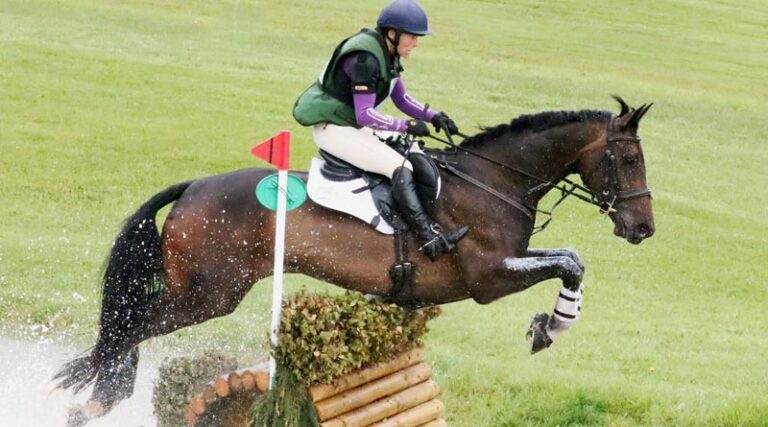
Several stride characteristics potentially linked to the onset of fatigue in the cross-country phase of Eventing were identified by researchers.
They found that these stride characteristics changed over time during high-level competitive cross-country testing.
“Monitoring these variables can contribute to the knowledge of the physiology of equine athletes and can help improve their management,” Dominik Burger and colleagues reported in the report. Equine Veterinary Journal.
The study team said fatigue and injuries associated with the musculoskeletal system are among the most common reasons for high-level eventing horses to withdraw from the sport. The safety of both horse and rider is important, and early detection of fatigue is crucial.
They set out to study elite eventing horses, focusing on biomechanical, cardiovascular and metabolic variables during cross-country testing, and to identify their potential associations with fatigue.
Their prospective observational and exploratory field study focused on 54 cross-country events performed by 33 horses during five high-level competitive events.
The study took place at the National Equestrian Institute of Avenches in Switzerland during the 2020 and 2021 seasons.
The study was integrated into three national eventing 4*-Masterclass training events with cross-country events, all part of the Swiss Equestrian Federation program.
After recruitment, and a few days before their cross-country events, each horse underwent a physical examination by FEI-accredited veterinarians to assess their suitability for competition. They were also weighed.
On the day of the cross-country, before leaving the stable, the saddle girth of all horses was fitted with a single sternal sensor for accelerometric evaluation, which was then removed immediately after the cross-country, when a Heart rate monitor was placed for 15 minutes. Blood was collected for lactate analysis.
Eventing horses from Switzerland, Italy, Ireland, Finland and Denmark, aged 8 to 19 years old, participated in the study.
The study team used data from the sternal sensor to explore stride parameters between and during jumps.
Differences in kinematic parameters between the start and end of the course were analyzed. Associations between blood lactate and heart rate recovery with kinematic variables were also evaluated.
They observed many changes in stride characteristics during and between jumps, which changed over time as the horses progressed through the courses.
Blood lactate concentrations were positively correlated with average peak striking power during jumps during the last minute of the run, and the latter was negatively correlated with average stride height during jumps.
The authors said their findings complement two recent studies using other inertial measurement units and examining sport horses before and after their training sessions.
The latest work identified new candidates for kinematic characteristics during competitive drills, such as peak punch power during jumps, that were associated with an altered jump profile. They potentially indicate the onset of fatigue, they said.
The evidence, they say, could also support the observation of trainers and riders that a tired horse’s jumping curve presents a different profile.
“We hypothesize that this finding represents compensation for the decline in muscle strength induced by high-intensity exercise through an increase in punching power (defined as acceleration in the vertical axis) at the level of jumps. .
“However, this hypothesis needs to be investigated in further studies, because to the authors’ knowledge, no scientific investigation on this topic exists in eventing or show jumping.
“In any case, all of these findings are of critical importance to cross-country design, particularly fatigue-related jumping characteristics and changes in stride length during a cross-country test , with direct consequences on the positioning of the subsequent elements of the combined obstacles.”
Indeed, they noted, a hypothesis was recently put forward according to which horse and rider fatigue would be a significant cause of falls, the longer a course and the greater the number of obstacles.
“In conclusion, our study identified several stride characteristics evolving over time during high-level competitive cross-country events and potentially linked to the onset of fatigue.
“Monitoring these variables can contribute to the knowledge of the physiology of equine athletes and help improve their management. »
The study team included Burger, Beatriz Vidondo, Vinzenz Gerber, Antonia Müller, Milena Scheidegger, Rebekka Käser and Alessandra Ramseyer, all of the University of Bern in Switzerland; and David Deillon, at Alogo Analysis SA in Renens, Switzerland.
Burger, D, Vidondo, B, Gerber, V, Deillon, D, Müller, A, Scheidegger, M et al. High-level competitive exercise and subsequent fatigue are associated with stride and jumping characteristics in eventing horses. Equine veterinarian J. 2023. https://doi.org/10.1111/evj.13999
The study, published under Creative Commons Licensecan be read here.
• Receive a notification when a new article is published:


